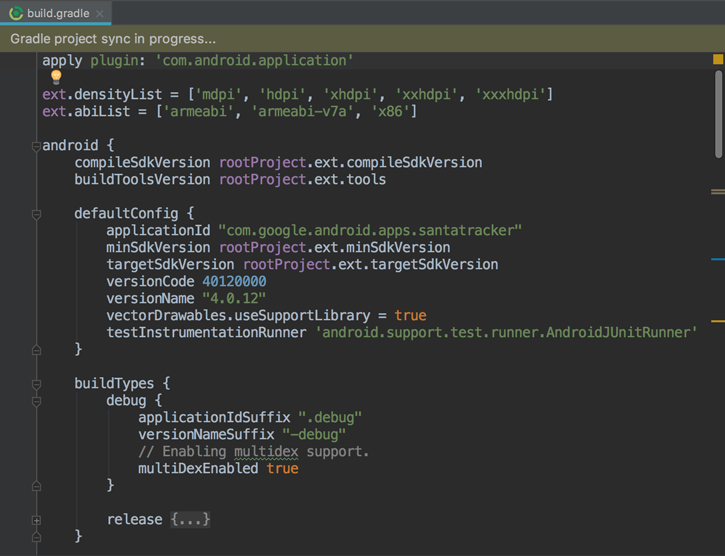
- #DOES ANDROID STUDIO INSTALL ANDROID SDK INSTALL#
- #DOES ANDROID STUDIO INSTALL ANDROID SDK UPDATE#
- #DOES ANDROID STUDIO INSTALL ANDROID SDK FOR ANDROID#
- #DOES ANDROID STUDIO INSTALL ANDROID SDK CODE#
#DOES ANDROID STUDIO INSTALL ANDROID SDK INSTALL#
It can be used to install an Android app file on any of your devices and allows you to access additional shell tools like bmgr and logcat. One of the tools included in this group is the Android Debug Bridge (adb). It works along with Build tools for encryption, security, and file size purposes. These tools are customized and used to support new features of Android’s latest version, as well as the prior versions. Now that you have a basic knowledge about the toolset, you should also understand that even if it contains almost everything you need to create and further develop an Android software, it still needs the support of other important command-line tools such as Platform tools, and the Android Emulator, in order for you to get started. Most importantly, it comes with an emulated virtual device that is fully functional that allows you to test out your work in progress. These tools are platform-independent and are essential in creating Android apps, regardless of the version you are working for.
#DOES ANDROID STUDIO INSTALL ANDROID SDK CODE#
This toolset includes a debugger, an emulator, Application Programming Interfaces (APIs), sample projects with source code as well as the required libraries to build Android apps.
#DOES ANDROID STUDIO INSTALL ANDROID SDK UPDATE#
It gives mobile software developers the opportunity to manually fix, text, profile, debug, and update their own software within the same platform.
#DOES ANDROID STUDIO INSTALL ANDROID SDK FOR ANDROID#
You don't need to wait for the updates when you can do it yourself.Īndroid SDK is a toolset that enables developers to create and update different apps for Android devices. For Windows, install the OEM USB drivers.A reliable toolset for creating and updating Android applications For macOS, no additional setup is required.

See the Android documentation for instructions. The Developer options menu may need to be enabled first. Open Settings, navigate to Developer options, and enable USB debugging. For more detailed instructions and information, see the Android documentation.


The following documentation is a quick way to set up Android devices for development. But first, the device must be set up for development. Set up an Android Device Īctual Android hardware can also be used for Ionic app development. Keeping the emulator running is the best way to ensure detection while developing Ionic apps for Android. Once the AVD is created, launch the AVD into the Android emulator. See Android version history for information on Android versions. If unsure, choose Pie (API 28) with Google Play services. The AVD Manager can also be opened inside Android projects in the Tools » AVD Manager menu.Ĭlick Create Virtual Device and select a suitable device definition. In the Android Studio welcome screen, click Configure » AVD Manager. For more detailed instructions and information, see the Android documentation.ĪVDs are managed with the AVD Manager. The following documentation is a quick way to get the Android emulator set up.
This path should be the Android SDK Location used in the previous section.įor apksigner and zipalign, $ANDROID_SDK_ROOT/build-toolsSet the ANDROID_SDK_ROOT environment variable. In ~/.bashrc, ~/.bash_profile, or similar shell startup scripts, make the following modifications: For Windows, check the documentation on setting and persisting environment variables in terminal sessions. The following instructions are for macOS and Linux. Before they can be used, some environment variables must be set. The Android SDK ships with useful command-line tools. To install system images and other minor SDK platform packages, you may need to ensure Show Package Details is checked at the bottom of the SDK Manager.įor future reference, the Android SDK can be managed with Android Studio in the Configure » SDK Manager menu of the Android Studio welcome screen or Tools » SDK Manager inside Android projects. Keep note of the Android SDK Location.īy default, the latest stable SDK Platform is installed, which includes a collection of packages required to target that version of Android. In the SDK Components Setup screen, finish installing the SDK. The IDE should detect that the Android SDK needs to be installed.

More detailed installation instructions can be found in the User Guide. Installing Android Studio ĭownload Android Studio from the Android website. Instead, it should only really be used to build and run your apps for the native Android platform and to manage the Android SDK and virtual devices. We don't recommend using Android Studio for developing Ionic apps.


 0 kommentar(er)
0 kommentar(er)
